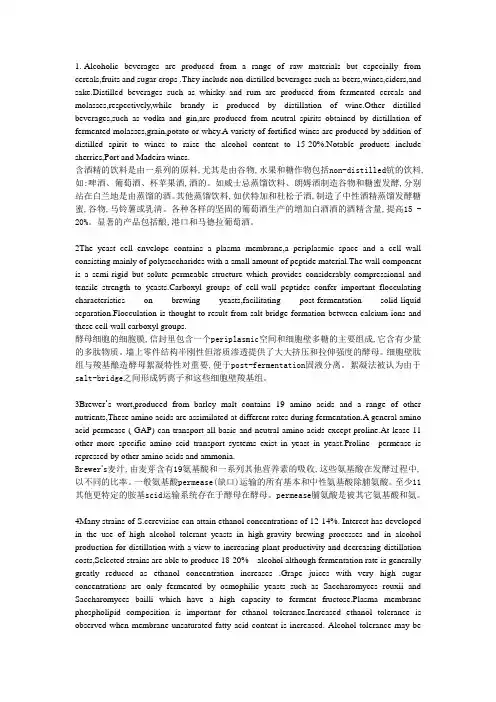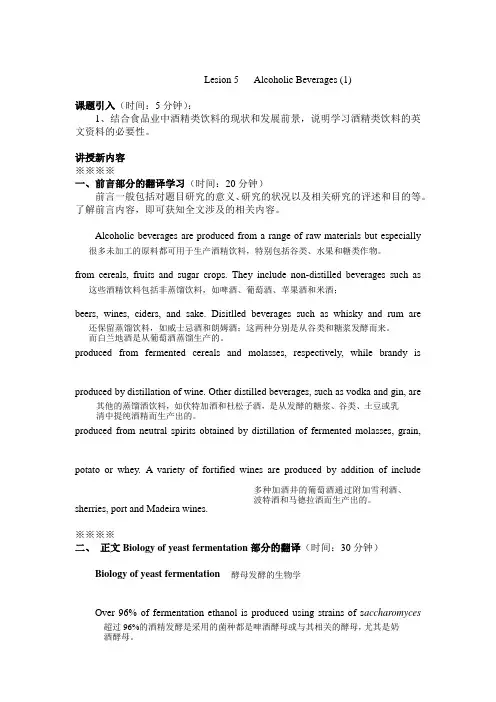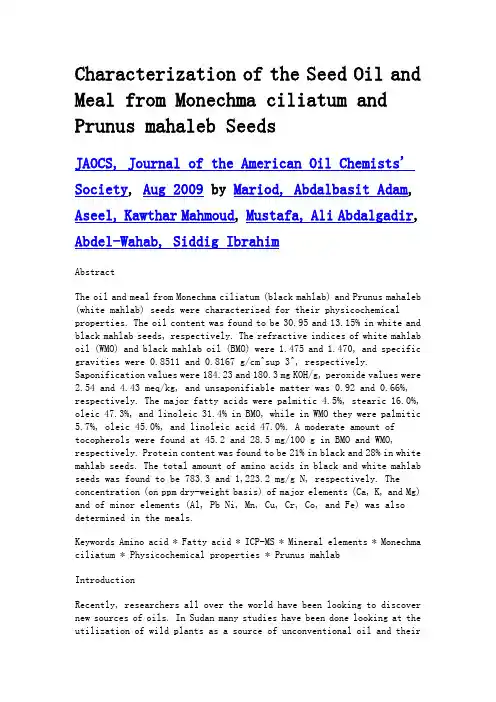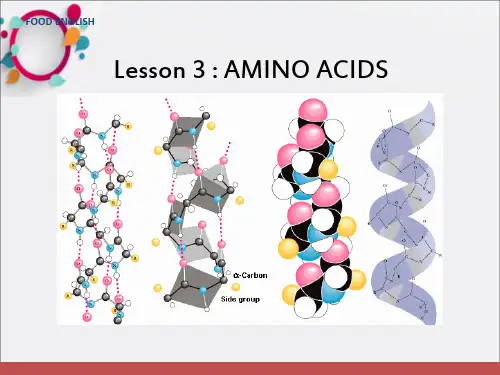食品专业英语课件带翻译
- 格式:ppt
- 大小:806.50 KB
- 文档页数:103



1.Alcoholic beverages are produced from a range of raw materials but especially from cereals,fruits and sugar crops .They include non-distilled beverages such as beers,wines,ciders,and sake.Distilled beverages such as whisky and rum are produced from fermented cereals and molasses,respectively,while brandy is produced by distillation of wine.Other distilled beverages,such as vodka and gin,are produced from neutral spirits obtained by distillation of fermented molasses,grain,potato or whey.A variety of fortified wines are produced by addition of distilled spirit to wines to raise the alcohol content to 15-20%.Notable products include sherries,Port and Madeira wines.含酒精的饮料是由一系列的原料,尤其是由谷物,水果和糖作物包括non-distilled钪的饮料,如:啤酒、葡萄酒、杯苹果酒,酒的。
如威士忌蒸馏饮料、朗姆酒制造谷物和糖蜜发酵,分别站在白兰地是由蒸馏的酒。
其他蒸馏饮料,如伏特加和杜松子酒,制造了中性酒精蒸馏发酵糖蜜,谷物,马铃薯或乳清。


英文文献暂时传不上去,名字叫fiavour formayron in meatand meat products:a revrew大家可以自己下载肉和肉制品中香气构成综述唐纳德S.莫特拉姆大学专业,食品科学与工艺,Whitek nights,读RG66AP,英国(1996年12月6日,接受1998年2月27日)摘要熟肉制品中的风味物质来自热反应过程,主要是美拉德反应和脂质降解反应。
这两种类型的反应涉及到复杂的反应途径,这就导致了产品多样性,以及熟肉制品中挥发性物质的量的增加。
杂环化合物,尤其是那些含有硫的物质是美拉德反应中产生的重要香气物质,它们提供咸、肉、烤、煮的气味。
脂质降解提供熟肉制品中具有脂肪香气的化合物以及那些用以区别不同品种肉的决定性香气物质。
美拉德反应过程中形成的化合物也可能与肉中的其他成分反应,增加整体香气的复杂性。
例如,脂质过氧化过程中形成的醛和其他羰基化合物已证实易于美拉德反应中间体反应。
这种相互作用会引起香气化合物的增加,但它们也修饰了肉香味化合物的整体香气。
特别是,这种相互作用可以控制含硫化合物和其他美拉德反应生成的挥发性物质的形成,以给予了熟肉制品最佳的风味特色。
⑤1998年爱思唯尔科技有限公司保留所有权利。
前言风味是描述肉类食用品质的重要指标,有关肉类风味物质的组成、化学性质及其在生产加工过程中影响风味形成的因素已有许多报道。
在加工方便美味食品中模拟肉类特征风味对形成所希望的特征性肉类风味是相当重要的。
肉类风味只有加热以后才能获得,而未烹调的肉类很少或没有香味,而只有血腥味。
在烧煮期间,瘦肉和脂肪组织中的非挥发性化合物之间发生了复杂的系列热诱导反应,从而导致大量反应产物生成。
尽管熟肉的风味受所形成的味感物质的影响,但在加热期间形成的挥发性化合物(嗅感物质)决定了其香味特征,并大大有助于形成特征性肉类风味。
已鉴定出的肉类挥发性化合物有1000多种。
与猪肉、羊肉或家禽相比,大部分化合物是从牛肉中鉴别出来的(Maarse与Visscher,1996年;莫特拉姆,1991年)。

Lesson5 Alcoholic beverages酒精饮料一、Questions:1 In the following contents, which belong to alcoholic beverages?beer, wine, carbonated beverage , fruit juice, tea drink2. Which types alcoholic beverages can you list?The alcoholic beverages include:non-distilled beverages :非蒸馏制取的酒精饮料(酿造酒)Beers, wines, ciders苹果酒, sake日本米酒distilled beverages : 蒸馏制取的酒精饮料whisk 威士忌酒, rum 朗姆酒, brandy 白兰地酒, vodka 伏特加酒, gin 杜松子酒fortified wines 强化葡萄酒, 加度酒sherries 雪利酒, Port 葡萄牙酒,Madeira wines马德拉酒.Distilled beverages : 蒸馏制取的酒精饮料whisk 威士忌酒Produced from fermented cerealsrum 朗姆酒Produced from fermented molassesbrandy 白兰地酒Produced by distillation of winevodka 伏特加酒Produced from neutral spirits obtained by distillation of fermented molasses, grain, potato or wheygin 杜松子酒Fortified wines 强化葡萄酒, 加度酒sherries 雪利酒,port 葡萄牙酒,madeira wines马德拉酒.produced by addition of distilled spirit to wines [to raise the alcohol content to 15-20% distilled spirit 精馏酒精alcohol content 酒精含量(浓度)3 Which materials can be used to produce alcoholic beverages?Alcoholic beverages are produced from a range of raw materials but especially from cereals, fruits and sugar crops.cereals 谷类(barley, rice, corn…)fruits (wine, apple, berry, waxbe rry…)sugar crops 糖类作物(cane, beet, potato…)酒精饮料可以从一系列的原材料,尤其是谷物、水果及糖类作物中制取。

Lesion 5 Alcoholic Beverages (1)课题引入(时间:5分钟):1、结合食品业中酒精类饮料的现状和发展前景,说明学习酒精类饮料的英文资料的必要性。
讲授新内容※※※※一、前言部分的翻译学习(时间:20分钟)前言一般包括对题目研究的意义、研究的状况以及相关研究的评述和目的等。
了解前言内容,即可获知全文涉及的相关内容。
Alcoholic beverages are produced from a range of raw materials but especially from cereals, fruits and sugar crops. They include non-distilled beverages such as beers, wines, ciders, and sake. Disitlled beverages such as whisky and rum are produced from fermented cereals and molasses, respectively, while brandy is produced by distillation of wine. Other distilled beverages, such as vodka and gin, areproduced from neutral spirits obtained by distillation of fermented molasses, grain, potato or whey. A variety of fortified wines are produced by addition of includesherries, port and Madeira wines.※※※※二、 正文Biology of yeast fermentation 部分的翻译(时间:30分钟) Biology of yeast fermentation Over 96% of fermentation ethanol is produced using strains of s accharomyces 很多未加工的原料都可用于生产酒精饮料,特别包括谷类、水果和糖类作物。

Characterization of the Seed Oil and Meal from Monechma ciliatum and Prunus mahaleb SeedsJAOCS, Journal of the American Oil Chemists' Society, Aug 2009 by Mariod, Abdalbasit Adam, Aseel, Kawthar Mahmoud, Mustafa, Ali Abdalgadir, Abdel-Wahab, Siddig IbrahimAbstractThe oil and meal from Monechma ciliatum (black mahlab) and Prunus mahaleb (white mahlab) seeds were characterized for their physicochemical properties. The oil content was found to be 30.95 and 13.15% in white and black mahlab seeds, respectively. The refractive indices of white mahlab oil (WMO) and black mahlab oil (BMO) were 1.475 and 1.470, and specific gravities were 0.8511 and 0.8167 g/cm^sup 3^, respectively. Saponification values were 184.23 and 180.3 mg KOH/g, peroxide values were 2.54 and 4.43 meq/kg, and unsaponifiable matter was 0.92 and 0.66%, respectively. The major fatty acids were palmitic 4.5%, stearic 16.0%, oleic 47.3%, and linoleic 31.4% in BMO, while in WMO they were palmitic 5.7%, oleic 45.0%, and linoleic acid 47.0%. A moderate amount of tocopherols were found at 45.2 and 28.5 mg/100 g in BMO and WMO, respectively. Protein content was found to be 21% in black and 28% in white mahlab seeds. The total amount of amino acids in black and white mahlab seeds was found to be 783.3 and 1,223.2 mg/g N, respectively. The concentration (on ppm dry-weight basis) of major elements (Ca, K, and Mg) and of minor elements (Al, Pb Ni, Mn, Cu, Cr, Co, and Fe) was also determined in the meals.Keywords Amino acid * Fatty acid * ICP-MS * Mineral elements * Monechma ciliatum * Physicochemical properties * Prunus mahlabIntroductionRecently, researchers all over the world have been looking to discover new sources of oils. In Sudan many studies have been done looking at the utilization of wild plants as a source of unconventional oil and theirmaximum utilities as antioxidants [1-3]. One of these wild plants, considered among the plants of the future, is black mahlab (Monechma ciliatum), which is well known in Sudan and belongs to the family Acanthaceae. Black mahlab is an annual glabrous herb, 30-65 cm high [4], with simple leaves measuring about 4-7 × 1-2 cm [5]. Black mahlab (Monechma ciliatum) is a famous medicinal plant in western Sudan, especially in the Nuba Mountains and Gabel Mara area. The seeds are used as an effective laxative and contain a fixed oil that emits a sweet and pleasant odor. Its further used in traditional Sudanese fragrances, lotions, and other cosmetics used for wedding preparation and childbirth [6]. In Botswana, Monechma ciliatum was believed to play an important role as a medicine for the remedy of general body pain, liver, and bowel trouble (diarrhea), as well as sterility in women [7]. The plant is used to induce labor and menses in Nigeria. It is also reported that the dried leaves are powdered and burnt as an inhalation for colds [8]. In Sudan, the dried entire plant is used for diarrhea, vomiting, and as a scent preparation. The seed oil content is 11.6% with iodine value of 69 and saponification value of 175.16; the fatty acid composition is 20.2, 17.3, and 17.9% for oleic, linoleic, and arachidic acid, respectively [9, 10]. Previous study by Uguru and others [5] showed that the hot methanol extract of the leaves of M. ciliatum has potent oxytocic property in vivo and in vitro, thus justifying its use in traditional medicine.White mahlab (Prunus mahaleb) is a deciduous tree, 1-2 m high, with many spreading branches; the bark is smooth and mahogany red. The leaves, which are up to 6 cm long, are bright green, shiny, oval, and finely toothed [H]. The white mahlab tree is a member of Rosaceae family, subfamily Prunoideae. The kernels of white mahlab seem to contain only small amounts of cyanogenic glycosides, but coumarin derivatives have been found. From the seeds, a fixed oil can be extracted that contains unusual conjugated linolenic fatty acid [12]. In Sudan, white mahlab is used in wedding preparations by crushing the seeds to manufacture traditional fragrances and lotions such as Dilka, Khumrra, and Darira. Also eating soaked white mahlab seeds is a remedy used for diarrhea in children. White mahlab is collected in Turkey and exported on a large scale. It is used in Turkey as a tonic or an antidiabetic in folk medicine and as a flavoring agent in making pies and candies. The white mahlab kernels form an important source of protein (30.98%) and fatty oil (40.40%). Its oil is also valuable in the preparation of lacquers and varnishes [12].Monechma ciliatum still grows as a wild plant in different areas in western Sudan states. No research data on its commercial production and its oil composition are available.Amino acid composition and protein digestibility measurements are considered necessary to predict accurately the protein quality of foods for human diets [13]. The widespread availability of vegetable oils around the world has resulted in the development of other oil-bearing plant species being neglected [14]. This study investigates the physicochemical and compositional properties including amino acids, minerals, trace elements, and fatty acids of seeds of the two mahlab plants, and a sensory evaluation of the oils obtained from these seeds is performed.Materials and MethodsSamples, Solvents, and ReagentsAll solvents used were of analytical grade. n-Hexane, methanol, chloroform, and petroleum ether were obtained from Prime for Scientific Services, Khartoum, Sudan. HCl, NaOH, HNO^sub 3^, and H^sub 2^O^sub 2^ were Suprapur grade (Merck, Darmstadt, Germany).Dried seeds of white and black mahlab were collected from a local market in Khartoum North, Sudan, then blended to obtain homogeneous samples, and pulverized before representative samples were taken for chemical analysis. For determination of the oven-dry weight, samples were dried at 105 °C for 24 h. Moisture and volatile matter in the samples were determined following a previously described method [15].Proximate Chemical AnalysisMoisture, lipid, ash, and crude-fiber contents were determined following the standard methods of the Association of Official Analytical Chemists [16]. The organic nitrogen content was quantified by the Kjeldahl method, and an estimate of the crude protein content was calculated by multiplication of the organic nitrogen content by a factor of 6.25 [17]. The two different samples were analyzed in triplicate. Total carbohydrate content was calculated from the difference, applying the formula:100% - (% protein % lipid %ash %fiber)Mineral AnalysisTwo replicate aliquote (500 mg) from each of the dried, powdered plant specimens were weighed, then wet-ashed by refluxing overnight with 15 mL of concentrated HNO^sub 3^ and 2.0 mL of 70% HClO^sub 4^ at 150 °C. The samples were dried at 120 °C, and the residues were dissolved in 10 mL of 4.0 N HNO^sub 3^-1% HClO^sub 4^ solution. The mineral content of each sample solution was determined by an Agilent Technologies 7500cinductively coupled plasma mass spectrometry (ICP-MS) system (Agilent Technologies, Wilmington, DE). Wavelengths used for the tested minerals were aluminum (Al) 396.152, calcium (Ca) 393.366, cadmium (Cd) 226.502, chromium (Cr) 206.149, cobalt (Co) 238.892, copper (Cu) 224.700, iron (Fe) 239.562, lead (Pb) 220.353, magnesium (Mg) 279.553, manganese (Mn) 257.610, nickel (Ni) 221.647, potassium (K) 766.490, and zinc (Zn) 213.856. The mineral contents of the samples were quantified against standard solutions of known concentrations, which were analyzed concurrently.Oil Extraction and DeterminationThe seeds were milled gently in a blender (Braun Multimix System 200, with Multimix deluxe grinder, MXK4 Germany), and oil was extracted by Soxhlet apparatus using petroleum ether 40-60 °C and determined following a previously described method [15]. The oil content was determined as a percentage of the extracted oil to the sample weight (w/w). The samples were analyzed in triplicate, then mean and standard deviation were calculated. The extracted oil was stored in a cold room (4 °C) in a dark glass bottle under nitrogen blanket for further analysis.Oil Physicochemical AnalysisFree fatty acids (FFA), iodine value (IV), saponification number (SN), peroxide value (PV), unsaponifiable matter, color, and refractive index (RI) were measured following a previously described method [15]. Color was determined using Lovibond Tintometer, Lovibond model E (Bicasa), suppUed by Griffin and Georgy, England, and refractive index was determined using an Abbe bench refractometer (model 46-315, England) with the temperature maintained at 30 °C. The analysis was done for the freshly extracted oils. The samples were analyzed in triplicate, then mean and standard deviation were calculated.Fatty Acid Composition by Gas Liquid ChromatographyThe fatty acid compositions of the seed oils were determined by gas liquid chromatography (GLC). The oils were converted to their corresponding methyl esters following a previously described method [15]. BF3/ methanol reagent (14% boron trifluoride) was used for methylation. GLC analysis of the fatty acid methyl esters (FAME) was performed using aHewlett-Packard HP5890 Series II gas Chromatograph (GLC) coupled to a flame ionization detector (FID) equipped with an Ultra 2 capillary column (25 m × 0.32 mm × 0.5 µm, 5% biphenyl and 95% dimethyl polysiloxane; Hewlett-Packard, Waldron, Germany), a split injector (split ratio 88:1), and an FID. The column temperature pro gram was 5 min at 150 °C, 10 °C/min to 275 °C, and 10 min at 275 °C. The injector temperature was 250 °Cwith a split ratio of 88:1. The carrier gas was hydrogen at a flow rate of 1.6 mL/min. The detector temperature was 280 °C with air and hydrogen flow rates of 460 and 33 mL/min, respectively. The fatty acid peaks were identified by comparing the retention times with those of a mixture of standard FAMEs (Sigma Chemicals, Deisenhofen, Germany). Each FAME sample was analyzed in duplicate.TocopherolFor determination of tocopherols, a solution of 250 mg of Monechma ciliatum and Prunus mahaleb oils in 25 mL ?-heptane was directly used for the HPLC. The HPLC analysis was conducted using a Merck-Hitachi (Tokyo, Japan) low-pressure grathent system fitted with an L-6000 pump, a Merck-Hitachi F-1000 fluorescence spectrophotometer (detector wavelengths for excitation 295 nm, for emission 330 nm), and a D-2500 integration system. The samples (20 µL each) were injected by a Merck 655-A40 autosampler onto a Diol phas e HPLC column (25 cm × 4.6 mm i.d.) (Merck) using a flow rate of 1.3 mL/min. The mobile phase used wasn-heptane/methy tert-butyl ether (MTBE) (99:1, v/v) [18].Amino Acid Composition by Amino Acid AnalyzerPreparation of Hydrolysate SampleThe content of dry matter and total N were determined according to procedures described by [16]. The content of amino acids (except for tryptophan) in defatted mahlab seeds was determined using Amino Acid Analyzer (L-8900 Hitachi-hitech, Japan) under the experimental conditions recommended for protein hydrolysates. Samples containing 5.0 mg of protein were acid hydrolyzed with 1.0 mL of 6 N HCl in vacuum-sealed hydrolysis vials at 110 °C for 22 h. The ninhydrine was added to the HCl as an internal standard. Hydrolysates were suitable for analysis of all amino acids. The tubes were cooled after hydrolysis, opened, and placed in a desiccator containing NaOH pellets under vacuum until dry (5-6 days). The residue was then dissolved in a suitable volume of a sample dilution Na-S buffer, pH 2.2 (Beckman Instr.), filtered through a millipore membrane (0.22-µm pore size) and analyzed for amino acids by ion-exchange chromatography in a Beckman (model 7300) instrument, equipped with an automatic integrator. Nitrogen in amino acids was determined by multiplying the concentration of individual amino acids by corresponding factors calculated from the percentage N of each amino acid [19]. The ammonia content was included in the calculation of protein nitrogen retrieval, as it comes from the degradation of some amino acids during acid hydrolysis [20, 21]. The ammonia nitrogen content was calculated by multiplying the ammonia content by 0.824 (N = 82.4% NH^sub 3^).Expression of ResultsThe composition of amino acids was expressed as milligrams per gram of N to estimate the quality of the protein in mahlab defatted seeds using the amino acid score pattern where amino acid ratio = (mg of an essential amino acid in 1.0 g of test protein/mg of the same amino acid in 1.0 g of reference prote in × 100). Nine essential amino acids were calculated by using a previously described method [13], where egg protein was used as reference protein.Sensory EvaluationPanelists were chosen to taste the two mahlab oils for characterization of their organoleptic properties (color, flavor, and taste). Oil samples were presented to the panelists in clear glasses at room temperature and in duplicate. The sensory analysis used was described in detail by Min [22]. Sensory qualities of the two oils were evaluated using a hedonic scale of 1-10, where 1 indicated the poorest flavor, color, and taste quality and 10 the highest organoleptic quality. The numerical results were then subjected to statistical analysis.Statistical AnalysisThe analyses were performed wi tìi three replicates. The mean values and standard deviation (mean ± SD) were calculated and tested using the Student's i-test (PResults and DiscussionProximate Chemical AnalysisThe proximate composition of the two mahlab seeds is given in Table 1. T he two samples showed significant differences (P ≤ 0.05) in all the analyzed constituents of the proximate composition except moisture content. The white mahlab seeds showed higher levels of lipid and protein content of 30.95 and 28.0 g/100 g, respectively, while black mahlab showed higher levels of fibers and carbohydrates content at 24.4 and 32.6 g/100 g, respectively. The results of oil content showed that white mahlab seed has a higher amount of oil (30.9 g/100 g) than the black mahlab seed (13.2 g/100 g). In 1981 Ayoub and Babiker [9] reported an oil content of 11.6% for black mahalb, which was higher than that reported in this study. Yücel [24] studied the seeds of Prunus mahaleb, and he found that die oil content ranged from 4.7 to 18.5 g/100 g, while Johansson et al. [25] mentioned that oil contents of Prunus mahaleb ranged from 12 to 16 g/100 g. The oilcontent of Prunus mahaleb in this study was higher than that found in these other studies.Oil Physicochemical PropertiesThe physicochemical properties of the two mahlab seed oils are shown in Table 2. Compared with Codex standards for crude vegetable oils [26], the white mahalab oil showed higher values for specific gravity, refractive index, acid value, peroxide value, saponification value, and unsaponifiable matter. Ayoub and Babiker [9] reported a lower saponification value (175.16) and a lower refractive index (1.4730) for black mahlab oil in comparison witìi me results in this study.From Table 2 it is instructive to note that the refractive indices for the white mahlab seed oil (1.475) and black mahlab seed oil (1.470) fall within the same range of 1.467-1.477 for grapeseed oil. The acid values for WMO and BMO of 7.8 and 7.3 mg KOHVg, respectively, were higher man the Codex standards for sunflower and ground nut oils, whilst the peroxide values for the WMO of 2.54 meq/Kg oil and for the BMO of 4.43 meq 02/Kg oil were less than that recorded for sunflower and ground nut oils in Codex standards. The percent unsaponifiable matter, shown in Table 2 for white mahlab (0.99%) and black mahlab (0.66%) seed oils, was less than that recorded for sunflower and ground nut oils in Codex standards [26].Sensory Evaluation of Black and White Mahlab OilTable 3 shows the results of the sensory evaluation for white and black mahlab oils. WMO oil scored more than 8 as overall score thus classifying the oil as better in color, odor, and taste. There was a significant difference (PFatty Acid CompositionThe fatty acid composition determined by GLC of the black and white mahlab oils is illustrated in Table 4. The major fatty acids in white mahlab seed oil were oleic (45.0%), linoleic (47.0%), and palmitic (5.7%). This result was higher than that reported by Yiicel [24], who reported 35.4, 28.5, and 4.6% for oleic, linoleic, and palmitic, respectively, in white mahlab seed oil. The major fatty acids in black mahlab seed oil were oleic (47.3%), linoleic (31.4%), stearic (16.0%), and palmitic (4.5%). This were higher than reported by Ayoub and Babiker [9] who reported 20.2, 17.3, and 12.5% for oleic, linoleic, and palmitic acids, respectively. They also reported 17.9% for arachidic acid, which was surprisingly not found in this study. The percentage of unsaturated fatty acids in white mahlab oil was 92.1%, while it was 79.9% in black mahlab oil. White mahlab oil was very richin both oleic and linoleic acid, while black mahlab oil was rich in oleic acid only.TocopherolThe tocopherol content of the oil from black and white mahlab seeds is given in Table 5. They had moderate amounts of tocopherols, 45.2 and 28.5 mg/100 g, respectively. The main tocopherol of the two samples wasγ-tocopherol, which represented 80.7 and 77.6% of the total, followed by a-tocopherol and δ-tocopherol, which represented 12.3 and 1.6 mg/100 g in BMO and 1.4 and 6.4 mg/100 g in WMO, respectively.Amino Acid ProfileThe amino acid profile of black and white mahlab seed, analyzed by amino acid hydrolysis, is presented in Table 6. The percentage ofsulphur-containing amino acids (methionine and cystine) in white mahlab seed was 3.9%, while in black mahlab it was 3.4% of the total amino acids, which was the lower than the other amino acids and was considered a reasonable amount for their important function in the cell processes in the oxidation and reduction system (cystine) and as a methyl donor (methionine) in metaboUsm. The total amount of the essential amino acids found in white and black mahlab seed was 623.8 and 454.8 mg/g N, respectively. The total aromatic amino acid levels (phenylalanine and tyrosine) found in white and black mahalab were 1 17.0 and 78.1 mg/g N, respectively. All the essential amino acids with the exception of tryptophan, which was not analyzed, were found to be present at low levels, and the total essential amino acids were found to be lower when compared to that of three different foods: broad bean (2740.0 mg/g N), wheat flour (1960.0 mg/g N), and soy flour (2,630.0 mg/g N) [27]. The total amount of the essential amino acids of white mahlab seed comprised about 50.9% of the total amino acids, which was less than that of black mahlab seed (58.0%).The chemical score suggested that the first limiting amino acid in black mahlab seed sample was methionine cystine followed by threonine, histidinen and isoleucine (Table 7). In the white mahlab seed sample, the chemical score suggested that the first limiting amino acids were threonine, methionine cystine, lysine, and isoleucine.Mineral CompositionMineral analyses are essential to guarantee the quality of any food product. ICP-MS aUowed us to determine the content of 13 minerals, many of which are required in human diets and others which are considered toxic.Table 8 summarizes the results of these analyses. Concentrations of major elements such as Ca, K, and Mg in white mahlab seeds (133.7, 204.2, and 102.2 ppm) were significantly (P <0.05)Table 8 also shows the content of potassium in black and white mahlab seeds was 204.2 and 80.53 ppm, respectively. Potassium plays an important role in human physiology, and sufficient amounts of it in the diet protect against heart disease, hypoglycemia, diabetes, obesity, and kidney disease. The content of magnesium in the studied samples (Table 8) was 102.2 and 69.13 ppm for BMS and WMS, thus providing 28.9 and 19.6% of the recommended dietary allowances [28], respectively. The concentrations of minor elements Al, Pb Ni, Mn, Cu, Cr, Co, and Fe levels were found at low levels in the studied samples.ConclusionsThe results reported here show that the seeds of two different species of mahlab plant collected in Sudan were different in their oil content and the physicochemical properties of that oil. Fatty acid composition was determined by GLC, and the major fatty acids were found to be 4.5% palmitic, 16.0% stearic, 47.3% oleic, and 31.4% linoleic in black mahlab oil. In white mahlab, the major fatty acids of me oil were found to be 5.7% palmitic, 45% oleic, and 47% linoleic acid. The amino acid profile of the defatted seeds as analyzed by amino acid analyzer indicated that the total amount of amino acids of black mahalb was 783 mg/g N and that of white mahlab was 1,223 mg/g N. The percentage of essential amino acids was 58.0% in black mahalb and 50.9% in the white mahlab. The results from sensory evaluation analysis of the two mahlab oils revealed that there was a significant difference (PAcknowledgements We thank Dr. B. Matthäus of M ax RubnerInstitute, Germany, for the analysis of tocpherols and Dr. Colin D. Costin of Cargill Global Food Research, USA, for his valuable help during the preparation of the manuscript. The third author thanks Mr. Mayudin Othman of Department of Land Management, Faculty of Agriculture, Universiti Putra Malaysia, for ICP-MS mineral analysis.美国油脂化学协会杂志J.JOTA-OCSAug.2009Characterization of the Seed Oil and Meal from Monechma ciliatum and Prunus mahaleb SeedsJAOCS, Journal of the American Oil Chemists' Society, Aug 2009 by Mariod, Abdalbasit Adam, Aseel, Kawthar Mahmoud, Mustafa, Ali Abdalgadir, Abdel-Wahab, Siddig Ibrahim.班级:学号:姓名:来自梅类缘毛和圆叶樱桃种子的植物油和粕的特性摘要来自梅类缘毛(黑樱桃)和圆叶樱桃(白樱桃)籽的植物油和粕因它们的理化性质而具有特性。

第一课营养1、营养的定义:Nutrition might be defined as the process whereby we obtain the essential nutrients and use them to make many other substances our bodies need.营养可定义为人们赖以获得的必须营养素,并利用这些营养素来制造人体所需的其他物质的过程。
2、营养过程的分类:This process would include eating and digesting food and absorbing and using,or metabolizing,the nutrients it contains.这一过程理应包括摄入和消化食物以及吸收和利用(即同化)其中所含的营养素。
3、营养物质:The ingredients that give us nourishment are called nutrients. These nutrients are categorized as fats,proteins carbohydrates (sugars and starches),minerals,vitamins,and water. They are called essential nutrients because we cannot get along without them. We need them for energy,for building and maintaining body tissue;and for regulating body processes the three essential functions of foods in the body.那些具有营养功能的成分称为营养素。
这些营养素可分为脂肪、蛋白质、碳水化合物(糖和淀粉)、矿物质、维生素和水。
